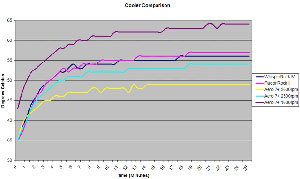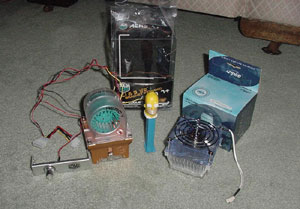|
|
Advertisement:
|
|
Cooler Master Aero 7+ and Spire WhisperRock IV |
|
Join the community - in the OCAU Forums!
|
Benchmarks and Conclusions
Benchmarks:
Now for the fun part of the review. I tested the Aero 7+ and the WhisperRock IV in the following system:
- Athlon XP 2100+
- 2300mhz
- 200*11.5
- 1.85 V-Core
- Epox 8rda+
- Kingston 512mb PC3200
- Single Channel
- 5-3-2-2
- 2.7v
- XFX GeForce4 Ti4200 64mb
- Antec SX1040B Case
- Antec 450w Solution PSU
- Cooling
- Fop32 @ 5volt on Ti 4200. Silent.
- 90mm and 80mm fans in PSU.
- Aero 7+ with a thin layer of Artic Silver 3 OR
- Spire WhisperRock IV with a thin layer of Artic Silver 3
As you can see my case severely lacks cooling. That means any heatsink in my system has to be up to the job. The main reason for this is the fact that I wanted a quiet system and am not yet prepared to head towards water cooling. I already had experience with the FalconRock II so I had a rough idea of how the WhisperRock IV would perform. The Aero 7+ was new territory, though.
To test the heatsinks I booted the machine from cold and entered windows. From windows loading I ran Prime95 torture test and at the same time I was encoding a Divx using Dr.Divx. I ran each test for 1 hour although I found that after 30 minutes the temperatures had stabilised so the below results only show the first 30 minutes of testing for each heatsink setting. All five tests that were executed followed the same procedure. The room temperature was stable throughout the benchmark process.

The first heatsink I tested was the Spire Falcon Rock II so I had something to compare the others to. The FalconRock II stabilized at 57 degrees after 19 minutes. Considering this CPU puts out a fair amount of heat the spire manages to pull a very respectful score at near silent sound levels.
Next was the WhisperRock IV. I didnít expect the WhisperRock IV results to differ from the FalconRock II results by much. The results show that the WhisperRock IV stabilized at 56 degrees after 18 minutes. This puts the WhisperRock IV ahead of the FalconRock II by one degree. Another bonus is the fact that the WhisperRock is quieter. This was a pleasant surprise as I would have thought with the decrease in noise there would have been a decrease in cooling performance but Spire managed to prove me wrong.
Next was the Aero 7+. It was tested at 1600rpm (lowest setting), 2500rpm (medium setting) and 3600rpm (highest setting). At 1600rpm the temps stabilized at 64 degrees after 22 minutes. The machine made it through the test at these temperatures although they were a bit too high for my liking. Especially considering the noise level was no less than the WhisperRock IV. The 2500rpm test showed the Aero 7+ performing 3 degrees better than the WhisperRock. It was slightly nosier although it wouldnít have been noticeable in most systems. Finally at full speed the Cooler Master stabilised only 15 minutes into the test and was a whole 8 degrees cooler than the Spire Falcon Rock II. I was very happy with these results as it showed that even though the Cooler Master isnít as loud as many other high end heatsinks on the market it still returned very good results.

Conclusion:
Although these heatsinks both have similarities they are both aimed at different markets. If you are after a budget no fuss great performing quiet heatsink then the WhisperRock IV is the heatsink for you. It has no trouble handling the above system which generates a fair bit of heat. It does all of this at a very low noise level. If noise is an issue in your environment then the WhisperRock IV is the perfect heatsink.
If on the other hand you donít mind spending extra and you have a larger tolerance for noise the Aero 7+ is definitely one of the better price/performance heatsinks on the market. The results speak for themselves. If you are more concerned about temperatures and overclocks then the Aero 7+ would be the wiser decision but keep in mind that the increase in performance does come with the cost of an increase in noise.
The Aero 7+ has found a place in my main computer. The adjustable fan speed means I can have it on full speed in situations when the noise wonít annoy me such as playing games or listening to music. On the other hand I can tone it down when doing desktop work. The WhisperRock has replaced the standard AMD heatsink in the families system. After many complaints about the noise generated by the default 2100+ AMD heatsink the family finally stopped their nagging towards me. Their computer is now quiet.
A big thanks to the suppliers of the two heatsinks in this review: Brian (Plaz) at Comfort Computing for supplying the Aero 7+ and Rod M at LowNoisePC (Importer/Distributor of spire products) for supplying the Spire WhisperRock IV.
|
|
Advertisement:
All original content copyright James Rolfe.
All rights reserved. No reproduction allowed without written permission.
Interested in advertising on OCAU? Contact us for info.
|

|


